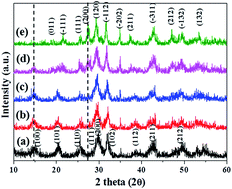GdPO4 : Eu3+ nanorods with the hexagonal phase, prepared by a simple co-precipitation method at 80 °C, were transformed to GdPO4 : Eu3+ nanoparticles with the monoclinic phase upon heating above 800 °C. Based on the in situ observations of XRD, TEM, and SAED, we suggested the phase transformation mechanism of the hexagonal nanorods to monoclinic nanoparticles via diffusion-controlled solid-state transformation. This is associated with the formation of a void inside the nanorods because of the elimination of water, rearrangement of atomic structure, and nucleation and growth of nanoparticles with different crystal structure. Ultimately, prepared GdPO4 : Eu3+ nanorods and nanoparticles can be utilized as an efficient multifunctional nanoprobe for magnetic resonance (MR)/optical imaging due to the prominent orange-red emission of Eu3+ ions at 592 and 615 nm, and the exhibition of saturated magnetization value (Ms) of 0.52 emu g−1 Oe−1 and high r2/r1 value.

